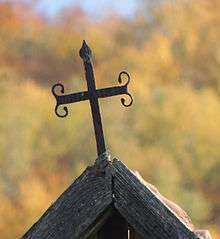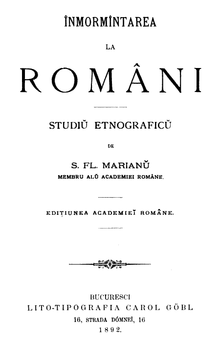Strigoi
Strigoi in Romanian mythology are troubled spirits that are said to have risen from the grave.[1] They are attributed with the abilities to transform into an animal, become invisible, and to gain vitality from the blood of their victims. Bram Stoker's Dracula has become the modern interpretation of the Strigoi through their historic links with vampirism.[2]

Etymology
Strigoi possibly originated from the Latin terms strix and striga, the root of which later has been related particularly to owls and commonly appears in related taxonomic terms for them, as well as for blood parasites such as the Strigeidida(Unrelated to subject). Cognates are found throughout the Romance languages, such as the Italian word strega or the Venetian word strìga which mean "witch". In French, stryge means a bird-woman who sucks the blood of children. Jules Verne used the term "stryges" in Chapter II of his novel The Castle of the Carpathians, published in 1892. The Greek word Strix, Polish strzyga and the Albanian word shtriga are also cognate.
In the late Roman period the word became associated with witches or a type of ill-omened nocturnal flying creature. A strix (Late Latin striga, Greek στρίγξ), referred to night-time entities that craved human flesh and blood, particularly infants'.[3]
Strigoi is a noun in Romanian, meaning exactly one risen from the grave. Also, the name strigoi is related to the verb a striga, which in Romanian means "to scream".
Historiography
Early reports
One of the earliest mentions of a historical strigoi was Jure Grando Alilović (1579–1656) from the region of Istria. The villager is believed to have been the first real person described as a vampire because he was referred to as a strigoi, štrigon or štrigun in contemporary local records.[4] Grando is supposed to have terrorised his former village sixteen years after his death. Eventually he was decapitated by the local priest and villagers. The Carniolan scientist Johann Weikhard von Valvasor wrote about Jure Grando Alilović's life and afterlife in his extensive work The Glory of the Duchy of Carniola when he visited Kringa during his travels.[5][6] This was the first written document on vampires.[7] Grando was also mentioned in writings by Erasmus Francisci and Johann Joseph von Goerres (La mystique divine, naturelle, et diabolique, Paris 1855), whose story was much more elaborate, full of fantastic details to make the story more interesting and sensational. In modern times, Croatian writer Boris Perić has researched the legend and written a book (The Vampire) on the story.[6]
Striga are mentioned by the Moldavian statesman and soldier, Dimitrie Cantemir, in his work the Descriptio Moldaviae (1714–1716). He thought that the striga were mostly Moldavian and Transylvanian beliefs. However, he associated them with witches or warlocks rather than blood-drinking undead vampires. The book ascribes dunking – a traditional test for witchcraft – as a method of identifying a striga.
Modern writings
An 1865 article on Transylvanian folklore by Wilhelm Schmidt describes the strigoi as nocturnal creatures that preyed on infants. He reports a tradition in which, upon the birth of a child, one tosses a stone behind oneself and exclaims "This into the mouth of the strigoi!"[8]
In 1909, Franz Hartmann mentioned in his book An Authenticated Vampire Story that peasant children from a village in the Carpathian Mountains started to die mysteriously. The villagers began to suspect a recently deceased count was a vampire, dwelling in his old fortress. Frightened villagers burned the castle to stop the deaths.[9]
Communist era
In his book In Search of Dracula, The History of Dracula and Vampires, Radu Florescu mentions an event in 1969 in the city of Căpăţâneni, where after the death of an old man, several family members began to die in suspicious circumstances. Unearthed, the corpse did not show signs of decomposition, his eyes were wide open, and his face was red and twisted. The corpse was burned to save his soul.[10]
During the Romanian Revolution of 1989, the corpse of Nicolae Ceaușescu did not receive a proper burial. This made the ghost of the former dictator a threat in the minds of superstitious Romanians. A revolutionary ectivist Gelu Voican carpeted the apartment of the Conducător with braids of garlic. This is a traditional remedy against the strigoi.[11]
Post-communist era
Before Christmas 2003, in the village of Marotinu de Sus, a 76-year-old Romanian man named Petre Toma died. In February 2004, a niece of the deceased revealed that she had been visited by her late uncle. Gheorghe Marinescu, a brother-in-law, became the leader of a vampire hunting group made up of several family members. After drinking some alcohol, they dug up the coffin of Petre Toma, made an incision in his chest, and tore the heart out. After removal of the heart, the body was burned and the ashes mixed in water and drunk by the family, as is customary. However, the Romanian government, anxious to maintain a good image in preparation for the country's accession to the European Union, had banned this practice, and six family members were arrested by the police of Craiova from Dolj County for "disturbing the peace of the dead",[12] and were imprisoned and sentenced to pay damages to the family of the deceased. The six who exhumed the body were charged and sentenced to six months' time served.[13] Since then, in the nearby village of Amărăştii de Sus, people drive a fire-hardened stake through the heart or belly of the dead as a "preventative".[14]
Mythology
Creation
The encyclopedist Dimitrie Cantemir and the folklorist Teodor Burada in his book Datinile Poporului român la înmormântări published in 1882 refer to cases of strigoism. The strigoi can be a living man, born under certain conditions:
- Be the seventh child of the same sex in a family
- Lead a life of sin
- Die without being married
- Die by execution for perjury
- Die by suicide
- Die from a witch's curse
Types
Tudor Pamfile in his book Mitologie românească compiles all appellations of strigoi in Romania strâgoi, Moroi[15][16] in western Transylvania, Wallachia and Oltenia, vidmă[17] in Bucovina, vârcolacul, Cel-rau, or vampire. The types described are:
Prevention & protection

In 1887, French geographer Élisée Reclus details burials in Romania: "If the deceased has red hair, he is very concerned that he was back in the form of dog, frog, flea or bedbug, and that it enters into houses at night to suck the blood of beautiful young girls. So it is prudent to nail the coffin heavily, or, better yet, a stake through the chest of the corpse."[19]
Simeon Florea Marian in Înmormântarea la români (1892) describes another preventive method, unearthing and beheading, then re-interring the corpse and head face-down.
The Dracula Scrapbook by Peter Haining, published by New English Library editions in 1976, reported that the meat of a pig killed on the 17 October, the feast day of Saint Ignatius, was a good way to guard against vampires, according to Romanian legend.[20]
There is a known method used by Romanians to get rid of a strigoi as explained on the show Lost Tapes:
- Exhume the strigoi.
- Remove its heart and cut it in two.
- Drive a nail in its forehead.
- Place a clove of garlic under its tongue.
- Smear its body with fat of a pig killed on St. Ignatius' Day.
- Turn its body face down so that if the strigoi were ever to wake up it would be headed to the afterlife.
Other uses
Strigoiulu (the Strigoi) was the name of a Romanian-language satirical magazine published briefly in 1862 in Pest.[21]
See also
References
- "Strigoi". www.dexonline.ro. Retrieved February 7, 2019.
- McLaughlin, Daniel (18 June 2005). "A village still in thrall to Dracula". The Guardian. London, England: Guardian Media Group. Retrieved 13 January 2019.
- Oliphant, Samuel Grant (1913). "The Story of the Strix: Ancient". Transactions and Proceedings of the American Philological Association. Philadelphia, Pennsylvania: American Philological Association. 44: 133–49. doi:10.2307/282549. JSTOR 282549.
- Vinšćak, Tomo (December 2005). "O štrigama, štrigunima i krsnicima u Istri" [On 'Štrige', 'Štriguni' and 'Krsnici' on Istrian Peninsula] (PDF). Studia Ethnologica Croatica. Department of Ethnology and Cultural Anthropology, Faculty of Humanities and Social Sciences, University of Zagreb. 17 (1): 231. ISSN 1330-3627. Retrieved 2011-11-04.
Drago Orlić je još prije dvadesetak godina (Orlić, 1986) prikupio i tiskao vrlo zanimljivo gradivo o ukorijenjenosti i životnosti tradicije vezane uz štrige i štrigune u Istri. ... Štrige i štriguni su najbliži pojmu vještica. Štrigun se rodi u črnem mihuru koji se potom sašije pod pazuh. Bez tog črnog mihura ili u drugoj varijanti crne kugle s kojom se rađa, gubi moć. Štrige i štriguni su opaki i vrlo opasni i po život ljudi, a piju i krv.
- Writer Boris Peric at the Literaturhaus in Switzerland
- Boris Perić, Vampir, Biblioteka 21, Zagreb (Naklada Ljevak) 2006. (Croat) ISBN 953-178-741-7
- Boris Perić, Vampir, translated into Slovene by Iztok Osojnik, Zbirka Beri globalno, Ljubljana (Tuma) 2007. ISBN 978-961-6682-05-3
- Schmidt, Wilhelm (1865). "Das Jahr und seine Tage in Meinung und Brauch der Rumänen Siebenbürgens". Österreichische Revue (in German). 3 (1): 211–226.
- Hartmann, Franz (May 16, 2009). "An Authenticated Vampire Story". scribd.com. Archived from the original on January 11, 2014.
- McNally, Raymond T.; Florescu, Radu R. (1994). In Search of Dracula, The History of Dracula and Vampires (Completely Revised). Boston, Massachusetts: Houghton Mifflin. pp. 8–9. ISBN 978-0-395-65783-6.
- "Le Feu vivant: la parenté et ses rituels dans les Carpates". persee.fr (in French).
- "Adevărul despre 'Cazul strigoiului Petre Toma'". indiscret.ro (in Romanian).
- Family interview on the Travel Channel, Expedition Unknown with Josh Gates, "Hunting Vampires"
- "Pour échapper aux vampires, rien ne vaut les vieilles recettes". courrierinternational.com (in French).
- Noul dicţionar explicativ al limbii Române, Bucharest: Litera Internaţional, 2002. ISBN 973-8358-04-3
-
- moroi in Dicţionarul explicativ al limbii Române, Academia Românǎ, 1998
- Definition of Vídmă
- DEX Online
- Nouvelle Géographie universelle, tome I, Hachette, Paris, 19 volumes, 1876-1894
- "The Dracula scrapbook". morduedevampires.pagespro-orange.fr (in French).
- "Publicaţiile Periodice Româneşti - PPR Tom. I. (1820-1906)". Bibliografia naţională retrospectivă. Biblioteca Academiei Române. Retrieved 18 March 2016.
Further reading
- Perkowski, Jan Lois (1998). "footnote 10 in 'The Romanian Folkloric Vampire'". In Dundes, Alan (ed.). The Vampire: a Casebook. Madison: University of Wisconsin Press. p. 46. ISBN 978-0-299-15924-5. citing Cantemir, Dimitrie (1714). "Striga". Descriptio Moldaviae (in Latin).
- Guiley, Rosemary Ellen (2004). "Strigoi". The Encyclopedia of Vampires, Werewolves, and Other Monsters. New York: Facts on File. pp. 268–270. ISBN 978-0-8160-4684-3.
External links
- Across the Forest, a documentary that interviews Transylvanian villagers about their experiences with strigoi, pricolici, and mama padurii.
- Tom Harris. How Vampires Work § Later Vampires at HowStuffWorks. This section of the vampire article contains a drawing of a strigo and a discussion of the strigoi's characteristics.